Mousepad Surfaces: Comprehensive Guide to Types, Materials, and Performance
Updated On: November 13, 2025 by Aaron Connolly
Understanding Mousepad Surfaces
The surface of your mousepad shapes how your mouse glides and tracks, which can totally change your gaming accuracy and speed. Material, texture, and smoothness all play a part in sensor performance and mouse control.
What Is a Mousepad Surface?
A mousepad surface is simply the top layer where your mouse moves. It sits right above the base that keeps the pad steady on your desk.
Different materials give each mousepad its own feel. Cloth surfaces feel soft and controlled, great for those careful, precise moves. Plastic surfaces feel harder and faster—ideal if you want quick, snappy reactions. Glass surfaces? They’re ultra-smooth and offer really consistent tracking.
Surface patterns matter too. Some pads come with micro-textures that pair up with specific mouse sensors. Others stick with a super-smooth finish, cutting friction down to almost nothing.
Most gaming mousepads use more than one layer. The top deals with your mouse, while a rubber backing keeps everything from sliding around. Quality pads often feature stitched edges, which help stop fraying and keep things intact for longer.
Importance of Smoothness and Texture
Smooth mousepads let you move your mouse quickly, barely feeling any resistance. That’s perfect for fast-paced games where you need to flick or sweep in an instant. With a uniform surface, your mouse sensor tracks accurately.
Textured pads offer more control. The extra friction can help you fine-tune your aim. Loads of esports pros prefer a bit of texture for tactical shooters where precision is everything.
Textures interact with sensors in different ways:
- Optical sensors love a lightly textured surface
- Laser sensors work best on smooth, even materials
- High-DPI sensors need a consistent surface to avoid tracking issues
As you use your mousepad, the surface changes. Smooth pads might develop rough patches, while textured ones slowly wear down and lose their grip. That can mess with your muscle memory and throw off your performance.
Mousepad Surfaces vs Desks
Wood desks can mess with tracking because of their grain and tiny bumps. Your mouse sensor can’t always handle those little changes, which leads to jittery cursors and tracking problems.
Glass desks seem smooth at first, but micro-scratches can mess up optical sensors. Suddenly your cursor skips or jumps, especially if you’re running high sensitivity.
Mousepad advantages over desks:
- The texture stays the same everywhere
- Friction levels match your gaming style
- Your desk and mouse feet last longer
- Sensors track better
Mousepads also protect your mouse feet. Rough desk surfaces chew them up fast, making movement scratchy and unpleasant. A good mousepad keeps your mouse gliding smoothly and helps it last longer.
Mousepad Materials Explained
The material of your mousepad changes how your mouse tracks, how long the pad lasts, and how comfortable you feel during long gaming sessions. The main types? Cloth fabrics for control, rubber bases for grip, and hard surfaces for speed.
Cloth and Fabric Mousepads
Cloth mousepads use woven fabric that gives you great control. Most gaming pros stick with cloth because the friction helps them aim more accurately.
Popular fabric types:
- Polyester – smooth glide and pretty durable
- Microfibre – super fine texture, awesome for optical sensors
- Canvas – rougher feel, maximum control
Weave density makes a big difference. Tighter weaves feel smoother and let you move faster. Looser weaves add texture, slowing things down for better precision.
Cloth pads work with both optical and laser mice. They don’t build up static that could mess with your tracking.
Pro tip: Grab a cloth pad with stitched edges. It’ll last way longer and won’t fray like the cheap ones.
Most cloth pads are machine washable. You can just toss them in when they get grimy—handy for both work and play.
Neoprene and Rubber Bases
Almost every quality mousepad uses rubber or neoprene as the base. That’s what keeps the pad from sliding around when things get intense.
Neoprene is a synthetic rubber that’s flexible and tough. It grips well without feeling sticky. Loads of premium gaming pads use thick neoprene, which also cushions your wrist.
Natural rubber bases grip the best on smooth desks. They’re a bit less bendy than neoprene but super stable.
Base thickness matters for comfort. Thin rubber bases (about 2mm) are perfect if you want speed. Thicker ones (4-6mm) give your wrist more support—huge if you’re gaming for hours.
Some bases have textured patterns underneath. That helps them grip glass or metal desks even better.
Heads up: Cheap rubber can stain light-colored desks after a while.
Plastic, Metal, and Glass Pads
Hard surface mousepads focus on speed. They’re made from solid stuff that lets your mouse glide with barely any drag.
Plastic mousepads are the most common hard type. They’re light, cheap, and easy to clean. Most offices use them since they handle lots of daily use.
Metal mousepads (usually aluminum) give you the smoothest glide. If you love fast shooters, these feel amazing for quick moves.
Glass mousepads are the luxury pick. They basically never wear out and always track the same. But they’re pricey and, honestly, they can feel a bit cold in winter.
Leather mousepads mix hard surface speed with a classic look. They develop a cool patina but need more care than synthetics.
Hard pads work best with optical mice. Some laser mice struggle on super-smooth stuff like polished metal or glass.
Hard Mousepads
Hard mousepads give you a solid, smooth surface for precise cursor control. Makers usually use plastic, aluminum, or resin that won’t warp or bunch up.
Advantages of Hard Surfaces
Hard pads bring a few big perks. The smooth surface means your mouse moves quickly and precisely, with barely any resistance.
Speed and precision really stand out. You can flick your mouse fast or make tiny corrections without feeling held back. That consistency helps you build muscle memory.
Durability is a major plus. Hard pads don’t wear out quickly or get grooves that mess with tracking. You can game hard for years and they’ll still hold up.
Easy cleaning is another win. Spills wipe right off, and dust doesn’t get buried in the surface like it does with fabric.
The base keeps things steady, even when you’re in the heat of a match. Soft pads sometimes bunch up, but hard mousepads stay put.
Wireless mice get a battery boost on hard pads. The even surface means the sensor doesn’t have to work as hard, so your battery lasts longer.
Ideal Use Cases for Hard Pads
Gamers, especially FPS players, get the most out of hard mousepads. The low friction lets you whip around and land shots quickly.
High-DPI gaming feels smoother on hard pads. You get better tracking at high sensitivity, with less jitter.
Designers and video editors often use hard pads for detailed work. Precision matters more than comfort for them.
If your desk space is tight, hard pads fit better since they’re thinner and don’t have bulky edges. They work fine on uneven surfaces too.
Travel setups benefit from hard pads. They don’t bend or crease in your bag, so they’re always ready to go.
Many offices like hard pads for their clean look and easy maintenance. They just fit better with modern workspaces.
Popular Materials in Hard Pads
Plastic tops the list for hard mousepads. They’re affordable and perform well. Most use polypropylene or similar plastics with a bit of texture.
You’ll usually see three layers: a smooth top, a solid core, and a rubber base for grip.
Aluminum pads are super durable and sometimes offer two different sides—one smooth, one textured. They look sharp and last basically forever.
Glass pads are the premium pick. They’re heavier and cost more, but tracking stays flawless.
Resin and polymer blends show up in some special pads. They balance speed with a touch of texture for more control, and they resist scratches better than basic plastics.
No matter the top, most hard pads use a rubber or silicone base to stop slipping and keep things sturdy.
Soft Mousepads
Soft mousepads give you a cushioned surface that lots of gamers find comfortable—especially for those long sessions. They’re usually made from cloth and offer solid control, though you’ll notice more friction than with hard pads.
Benefits of Soft Surfaces
Soft pads really shine when you want precise control over your mouse. The fabric adds just enough resistance to help you stop right where you want. That’s huge for games where careful aiming matters.
Comfort is a big deal here. Your wrist rests on something soft, not cold plastic or glass. Some even add gel wrist rests for extra support during those marathon gaming nights.
I’ve found soft pads work well at all sorts of mouse sensitivities. The texture grips your mouse feet, so you stay accurate whether you’re making tiny tweaks or big moves.
They’re affordable, too. You can pick up a decent cloth pad for less than £15. Fancy RGB ones cost more, but basic models work great and don’t empty your wallet.
Cleaning is easy. Most soft mousepads can go right in the wash or be scrubbed with soap and water. That keeps things fresh.
Typical Materials in Soft Mousepads
Cloth leads the pack for soft pads. Most feature woven fabric that balances speed and control. Tighter weaves feel smoother, while looser ones slow your mouse a bit for more stopping power.
Neoprene is the go-to for the base. This rubbery material keeps your pad from sliding and adds some cushioning. It’s tough and shrugs off water.
Foam padding sits in the middle. This layer makes the pad feel soft or firm. Thicker foam means more cushion, but sometimes less stability if you’re moving fast.
Some high-end soft pads use hybrid materials. They mix cloth with special coatings that reduce drag, trying to give you comfort and speed at once.
Stitched edges stop fraying. The best pads reinforce the borders, so the fabric doesn’t peel away. Cheaper ones skip this and fall apart much quicker.
Best Uses for Soft Pads
Strategy games and MOBAs feel great on soft mousepads. If you play League of Legends or Dota 2, you know how important precise clicking and steady mouse movement is. Cloth surfaces let you target enemies with real accuracy.
Soft pads work well for office tasks and everyday computing, too. When you’re editing documents for hours or just browsing, comfort matters more than you’d think. At the end of a long day, your wrist will appreciate the difference.
MMO players usually go for soft surfaces. These games need lots of clicking and moderate mouse movement. The stopping power of a soft pad helps you hit those tiny UI buttons reliably.
If you’re just starting out, soft mousepads make life easier. They forgive less-than-perfect technique and help you build up muscle memory without overshooting your targets.
Long gaming sessions feel better on soft pads. The extra cushioning reduces fatigue compared to hard pads. If you’re gaming for hours, comfort can really make or break your performance.
Surface Texture and Performance
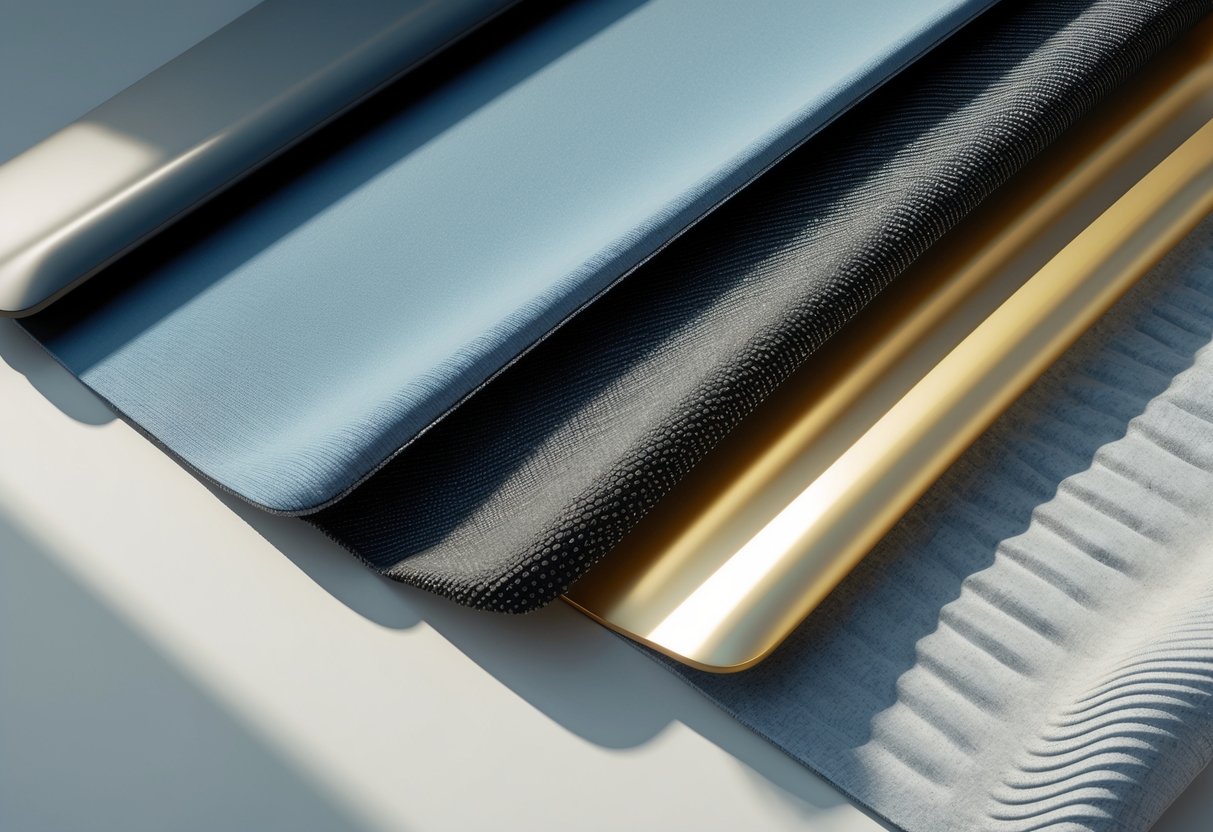
Surface texture has a huge impact on how your mouse sensor picks up movement and translates it to cursor accuracy. The texture decides if you get quick, effortless glides or more grip for pixel-perfect moves.
Effect on Computer Mice and Sensors
Modern gaming mice use optical or laser sensors that snap thousands of images per second from the mousepad’s surface. Sensors need a consistent texture to track movement properly.
A smooth surface gives uniform tracking, but sensors can lose precision during really fast moves. The sensor can struggle when there aren’t enough details to lock onto.
Textured surfaces give the sensor more visual cues for movement. You get more reliable tracking, especially during quick flicks or sudden direction changes—exactly what competitive players need.
But if a surface gets too rough, it can overwhelm the sensor. That leads to jittery cursor movement or tracking errors mid-game.
Most pro esports players stick with medium-textured surfaces. These offer enough detail for accurate sensor reading without slowing things down with too much friction.
Smooth vs Textured Finishes
Smooth finishes let your mouse glide with barely any resistance. You’ll find these on hard plastic or glass pads built for speed.
These surfaces are perfect for:
- Low-sensitivity setups
- Wide, sweeping arm movements
- Fast shooters where quick turns matter
- Tasks that need rapid cursor shifts
Textured finishes add more friction and tactile feedback. Cloth mousepads get their texture from woven fibers or printed patterns.
Textured pads shine for:
- High-sensitivity setups
- Pinpoint aiming in tactical shooters
- Graphic design that needs pixel accuracy
- Preventing accidental slips
Your gaming style really decides which texture works best. Aggressive players might love smooth pads, while tactical folks stick to textured ones for more control.
Friction, Speed, and Control
Friction decides the balance between speed and control—and that’s what shapes your gaming performance. Low-friction pads focus on speed, while high-friction ones give you more control.
| Surface Type | Friction Level | Best For | Gaming Style |
|---|---|---|---|
| Glass/Hard Plastic | Very Low | Speed | Aggressive/Fast |
| Smooth Cloth | Low-Medium | Balanced | Versatile |
| Textured Cloth | Medium-High | Control | Tactical/Precise |
Speed-focused surfaces cut resistance, so you can whip your mouse around with barely any effort. Counter-Strike pros often pick these for quick peeks and fast rotations.
Control-focused surfaces add resistance, letting you stop on a dime and make tiny adjustments. Tactical FPS players and graphic designers love this for extra precision.
Try out different friction levels to find what works for you. Some gamers even swap surfaces depending on the game.
Quick win: Use a smooth spot on your desk as a quick test for low friction, then switch to a textured mousepad to feel the difference instantly.
Gaming Mousepad Surfaces
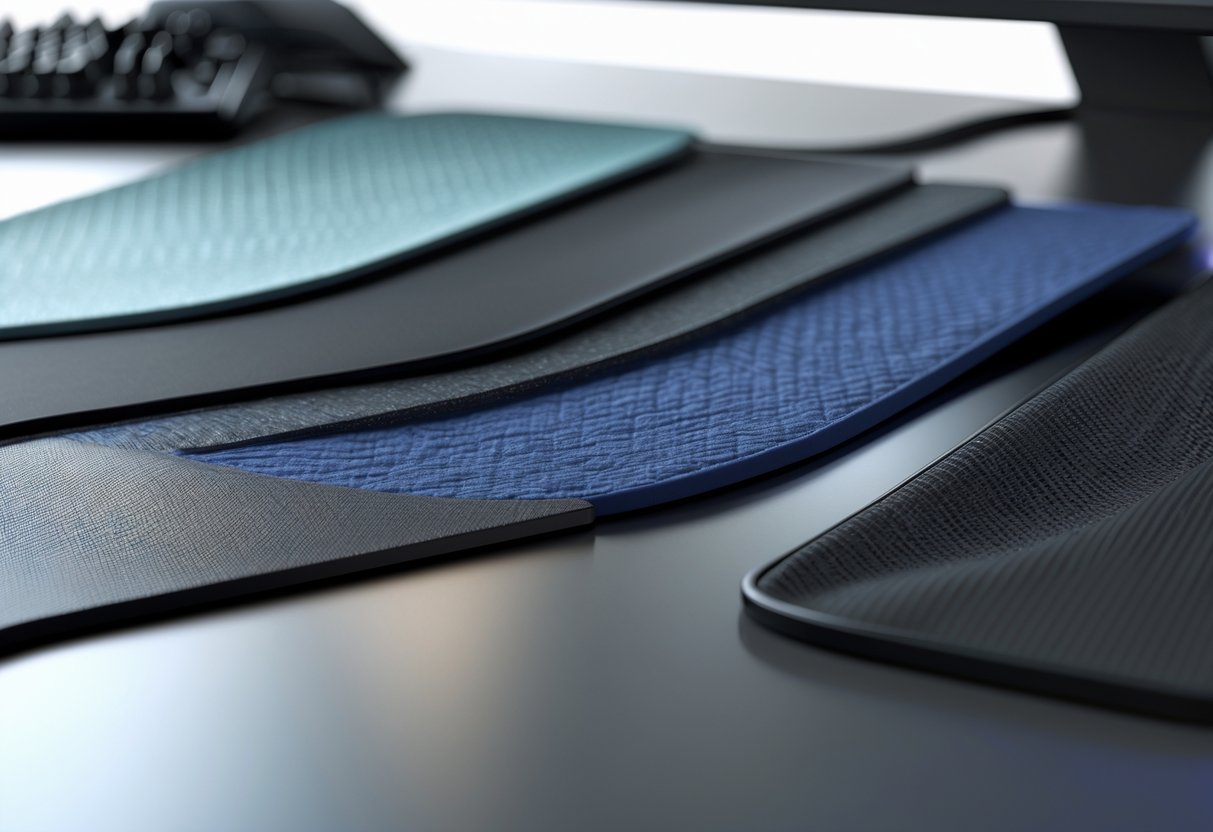
Gaming mousepads use materials designed for competitive players who want precise tracking and steady performance. Hard pads focus on speed, while soft cloth pads prioritize control and comfort for those marathon sessions.
Features for Gaming Performance
Gaming mousepads stand out from standard office pads thanks to their engineered surfaces. Getting the right speed and control balance is crucial for competitive play.
High-quality gaming pads keep their surface texture consistent. This gives you top-notch sensor tracking with both laser and optical mice. You won’t have to worry about sensor skipping during quick moves.
Low-friction surfaces help you start and stop your mouse on a dime. That’s pretty important when every split second counts.
Many gaming pads come with anti-slip rubber bases. These keep your pad from sliding around during intense matches. Cloth pads often have stitched edges to stop fraying.
Some gaming mousepads even have special coatings. These keep the glide feeling consistent, even after months of heavy use. The materials are built to resist wear from all that mouse movement.
Surface Options for Gamers
Hard surfaces deliver the fastest mouse movement with almost no friction. Plastic and aluminium pads are great for low-DPI gaming and big sweeping motions.
These pads keep their texture over time and wipe clean with no fuss. Hard pads also shrug off moisture easily.
Soft cloth surfaces give you better control for precision aiming. The SteelSeries QcK series, for example, uses micro-woven cloth for smooth, reliable tracking.
Cloth pads offer more stopping power for placing your cursor exactly where you want it. They handle both high and low DPI settings with ease.
Hybrid options blend speed and control zones. Some pads have different textures in different areas, so you can switch up your playstyle on the fly.
| Surface Type | Speed Rating | Control Rating | Durability | Price Range |
|---|---|---|---|---|
| Hard Plastic | High | Medium | Excellent | £15-40 |
| Cloth | Medium | High | Good | £10-30 |
| Hybrid | Variable | Variable | Good | £25-60 |
Extended and Oversized Gaming Pads
Extended mouse pads cover your whole desk. Most measure 900mm x 400mm or even larger, so you’ve got room for both your mouse and keyboard.
Big pads make sure you never run out of space, especially with low-sensitivity gaming that needs wide arm swings.
They also protect your desk from scratches and scuffs. Plus, a unified gaming surface just looks clean and organized.
Why go oversized?
- Same surface across your setup
- No edge to bump into during games
- Extra desk protection
- Clean, uniform look
Some extended pads even have RGB lighting around the edges. You can sync these with your other gear for a cool light show.
They do take up more space and need a bit more cleaning. Still, most gamers agree the benefits are worth it.
Durability and Lifespan
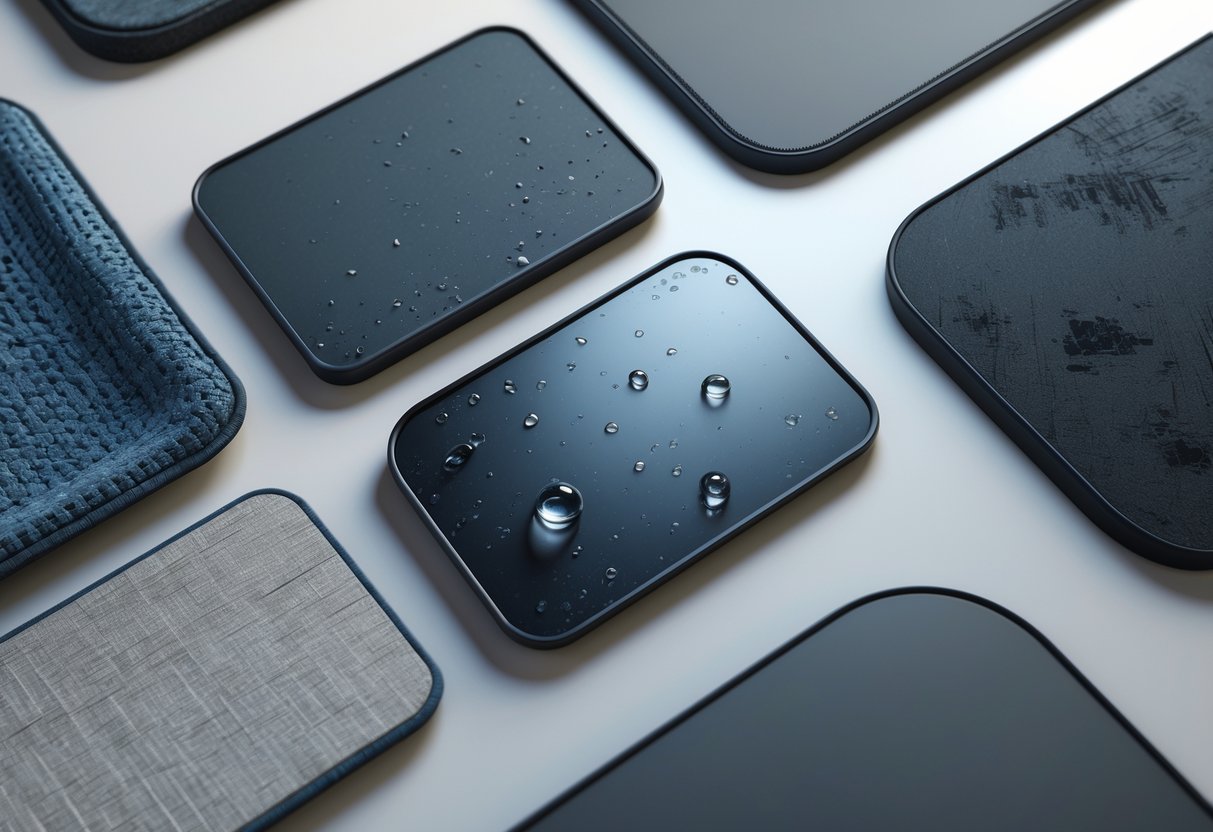
Mousepads usually last anywhere from 6 months up to 5 years, depending on material quality and how you treat them. Good habits and starting with a quality pad can really stretch out its lifespan.
Factors Affecting Durability
Mouse pad material is the biggest factor in how long your pad lasts. Cloth pads tend to wear out faster than hard plastic or aluminium.
High-quality woven fabric pads resist fraying better than cheap ones. With regular use, they last around 1-2 years.
Hard mousepads made from plastic or metal offer top-notch durability. These can last 2-5 years since they resist most wear and tear.
| Material Type | Average Lifespan | Pros | Cons |
|---|---|---|---|
| Cloth | 6 months – 2 years | Comfortable, quiet | Wears quickly, stains easily |
| Plastic | 2-4 years | Smooth, easy to clean | Can feel harsh |
| Aluminium | 3-5 years | Most durable | Expensive, cold surface |
How often you use your pad makes a big difference. If you game a lot or work long hours, you’ll see wear faster.
Your mouse type also matters. Some optical mice create more friction, which can wear down pads quicker.
How to Extend Mousepad Longevity
Clean your mousepad every week to stop dirt from building up and wearing out the surface. Just use a damp cloth and a bit of mild soap for a quick wipe-down.
For deeper cleaning, soak cloth pads in warm soapy water for about 15 minutes. Always let them air dry fully before you use them again.
Skip harsh chemicals or rough cleaners—they can wreck the surface. Stick to gentle soap and water.
Keep food and drinks away from your pad. Spills leave stains and sticky spots that mess with mouse tracking.
Store your pad flat or roll it loosely when you’re not using it. This keeps it in shape and avoids creases.
If you’re a heavy user, try rotating between two mousepads. This lets each pad recover and last longer.
Heads up: Don’t toss your mousepad in the washing machine unless the manufacturer says it’s okay. Most pads can fall apart or lose their backing that way.
Non-Slip and Ergonomic Features
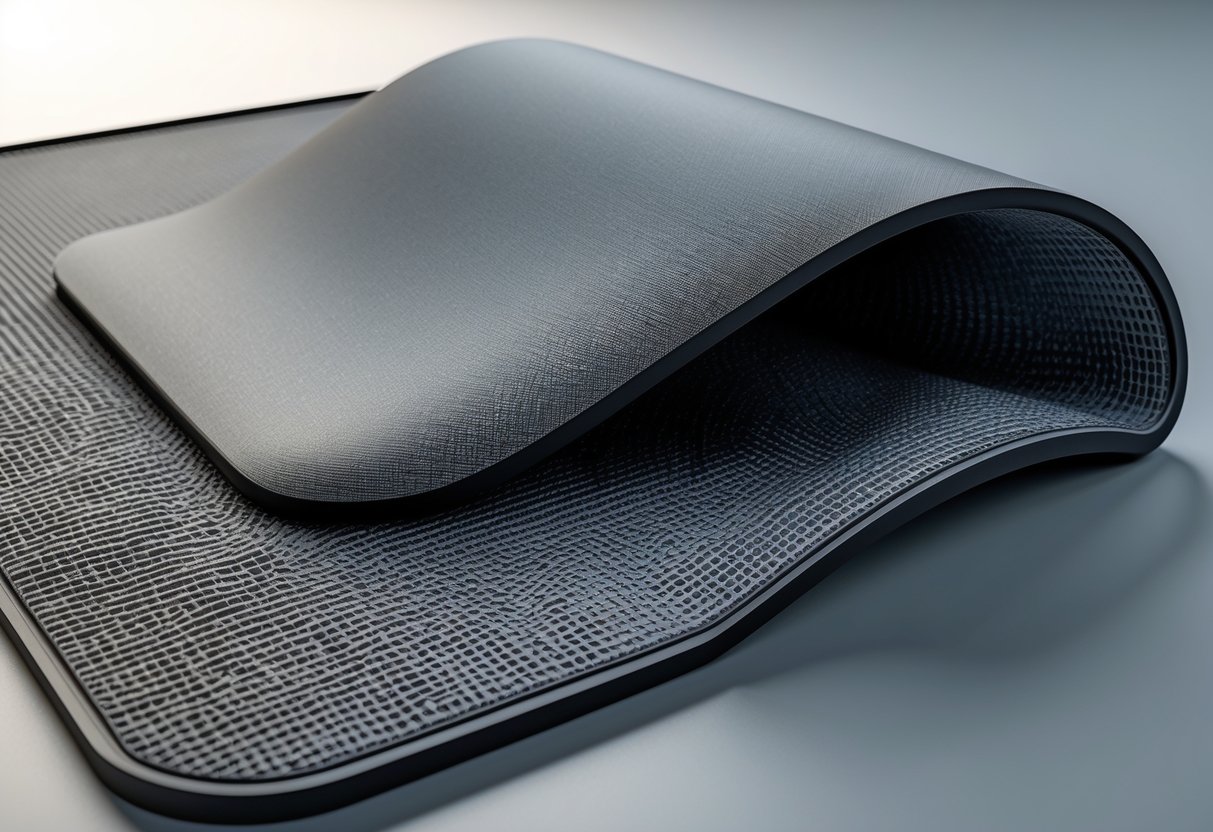
Non-slip bases keep your mousepad steady on your desk, even when games get intense. Ergonomic wrist rests take off some strain during long practice sessions or tournaments.
Non-Slip Bases and Desk Stability
A good non-slip base stops your mousepad from sliding when it matters most. Most gaming pads use rubber or PU (polyurethane) bases that grip smooth desks really well.
Textured undersides create friction with your desk. So when you go for a quick flick shot or rapid move in games like Valorant, your pad stays in place.
What to look for in non-slip bases:
- Natural rubber backing for max grip
- PU base material for durability
- Textured patterns for extra contact
- Anti-slip treatments that last
Your desk surface affects grip, too. Glass and polished wood give rubber bases the best hold. Fabric desk covers or rough surfaces might make the pad slide a bit more.
Wrist Rests and Comfort Enhancements
Ergonomic wrist rests help you keep good hand posture during long sessions. They lower your risk of repetitive strain injuries—something a lot of competitive players deal with.
Memory foam wrist rests shape themselves to your wrist. They offer steady support and let you move just enough while playing. The foam bounces back after you’re done.
Gel-filled cushions feel softer and stay cool, even in long matches. They spread out pressure better than foam but might feel less stable if you’re aiming for pixel-perfect shots.
Most ergonomic pads put the wrist rest at the bottom edge. This keeps your wrist in a neutral spot—not bent up or down. For most people, 15-25mm is the sweet spot for height.
Go for wrist rests with breathable fabric covers. These stop sweat and chafing during heated games. Some covers even come off for easy cleaning.
Choosing the Right Mousepad Surface

Your choice of surface material changes how your mouse feels and performs. Some materials work better for gaming, others for office or creative work. You’ll find everything from budget cloth pads to fancy leather ones.
Matching Surface to Use Case
Pick a mousepad surface that fits how you use your mouse every day. Gaming mouse pads need to handle fast moves and precise tracking under pressure.
For competitive gaming, hard plastic surfaces make a lot of sense. They offer low friction and consistent tracking, which is ideal for shooters and strategy games.
Office work feels better on cloth pads. The softer texture is easier on your wrist during long hours and still gives you solid control.
If you’re into creative work or design, you want a surface with great precision. Cloth pads with fine weaves give you the control you need for detailed editing.
Quick win: Try your usual sensitivity settings on a few different surfaces. You’ll quickly notice which one feels best for your style.
Comparing Materials for Different Needs
Every mousepad material brings its own perks for different users:
| Material | Best For | Pros | Cons |
|---|---|---|---|
| Cloth | General use, comfort | Soft, quiet, affordable | Can wear out, harder to clean |
| Hard plastic | Gaming speed | Fast, easy to clean, durable | Can be noisy, less comfortable |
| Leather mouse pad | Professional settings | Premium feel, easy to clean | Expensive, limited tracking options |
| Rubber | Budget option | Cheap, non-slip base | Limited durability |
Cloth mousepads suit most people. They offer a nice balance between speed and control, plus they’re pretty comfy for long sessions.
Hard pads are for gamers who want speed above all. The slick plastic lets you whip the mouse around fast, with almost no drag.
Budget and Premium Options
Basic cloth mousepads usually cost about £5-10. They’re fine for everyday use and even some light gaming.
If you spend a bit more, say £15-30, you get better materials and stitched edges. Gaming mouse pads in this range hold up well to regular use.
Premium mousepads can cost £40-80 or more, especially if you want something fancy. Leather mouse pads land in this bracket, mostly for the look and feel in a professional setup.
Just a heads-up: spending a lot doesn’t always mean better performance. A £10 cloth pad often does the job just as well for most folks.
If you’re not sure, start with a decent cloth pad for around £15-20. Only upgrade if you notice you actually need something special.
Cleaning and Maintenance
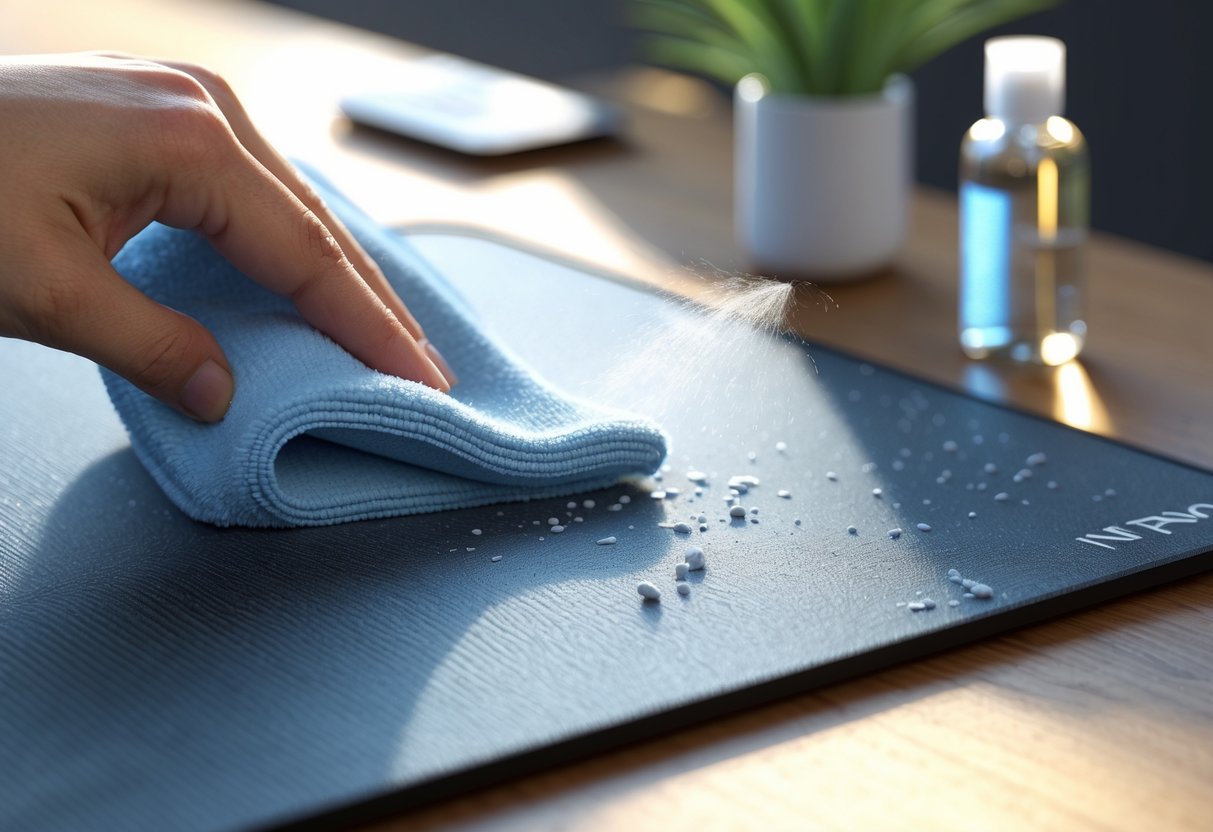
Keeping your mousepad clean helps it last longer and work better. Each material needs a slightly different approach to avoid damage.
Best Practices for Cloth Pads
Cloth mousepads need gentle care to keep their texture. If you wipe them down regularly, you can stop dirt from messing with your mouse tracking.
For quick cleans, just grab a microfiber cloth and a bit of disinfectant spray. Wipe the surface gently to clear away dust and oils.
Weekly Deep Clean Steps:
- Fill a basin with lukewarm water.
- Add a bit of mild washing-up liquid (skip the strong stuff).
- Gently scrub with a soft cloth or brush.
- Rinse until there’s no soap left.
- Let it air dry flat.
Never use:
- Hot water (it wrecks the fibres)
- Fabric softeners or scented soaps
- Abrasive brushes or scouring pads
- Direct sunlight for drying
Try not to overwash your cloth pad. Too much cleaning wears it out. Deep clean only when it’s really needed.
Let it dry completely on a flat surface. Usually, this takes about 4-6 hours, depending on thickness.
Caring for Hard Mousepads
Hard mouse pads—plastic, glass, or metal—are easier to keep clean. They shrug off stains and dry fast.
For daily cleaning, just use a dry microfiber cloth to wipe away dust and fingerprints. Circular motions work best.
For deeper cleaning:
- Mix a drop of mild washing-up liquid with lukewarm water.
- Dampen your cloth (don’t soak it).
- Wipe the surface gently.
- Dry with a clean microfiber cloth to avoid streaks.
Glass and metal pads scratch easily. Stick to soft cloths, not rough sponges or paper towels.
Avoid:
- Spraying cleaner right onto the pad
- Alcohol-based cleaners (they can mess with coatings)
- Water near the edges or base
- Harsh glass cleaners
Most hard mousepads need cleaning a couple of times a week. If you’re gaming with sweaty hands, you might need to wipe it down more often.
Customisation and Design
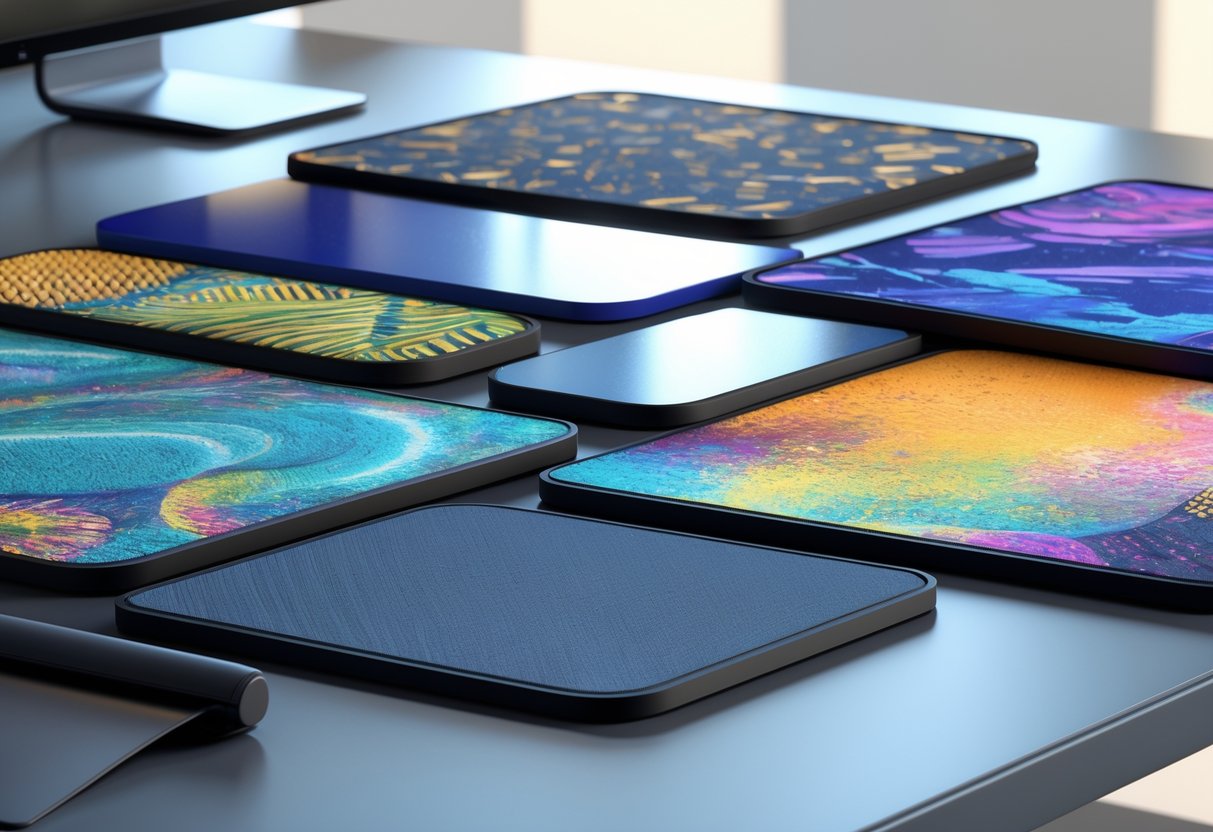
These days, you can personalise a mousepad any way you want. Customisation options are everywhere—upload your own artwork, pick shapes, sizes, colours, you name it.
Personalised Graphics and Printing
Most custom mousepad makers let you upload images, logos, or whatever art you like right into their design tool. They usually print using heat transfer tech on a polyester cloth surface.
Image quality really matters here. High-res files (think 300 DPI or better) will keep your design looking sharp.
Just so you know: dark colours might print a bit lighter, and sometimes tiny white dots (under 1mm) sneak into the design because of the heat transfer process.
Popular ways to customise:
- Family photos or custom art
- Team logos for gaming squads
- Company branding for work setups
- Anime or game characters
- Abstract patterns
Custom gaming mouse pads still work great with both optical and laser mice. Printed surfaces stay smooth enough for accurate cursor movement.
Most companies need 3-7 days to make your custom pad. Bigger desk mats can take longer, mostly because of all the edge stitching.
Shape, Size, and Colour Choices
Standard mousepad sizes go from small (about 20cm x 25cm) to huge desk mats (up to 90cm x 120cm). Gaming mats often come in extra-long sizes that cover your whole desk.
Shape options:
- Regular rectangles
- Rounded corners
- Custom cut shapes (these cost extra)
- Funky, irregular shapes (requires manual cutting)
Most places offer basic stitching in black, white, or clear. If you want a different colour, you can usually ask after ordering.
The base is almost always anti-slip natural rubber, so your pad stays put. Some premium pads even have RGB lighting or wireless charging built in.
If you’re not sure where to start, grab a standard rectangle in a medium size (about 30cm x 60cm). It’s a good mix of price and usability.
Custom shapes cost more since they take extra work. If you want something wild, talk to the manufacturer first about what’s possible and how much it’ll cost.
Frequently Asked Questions
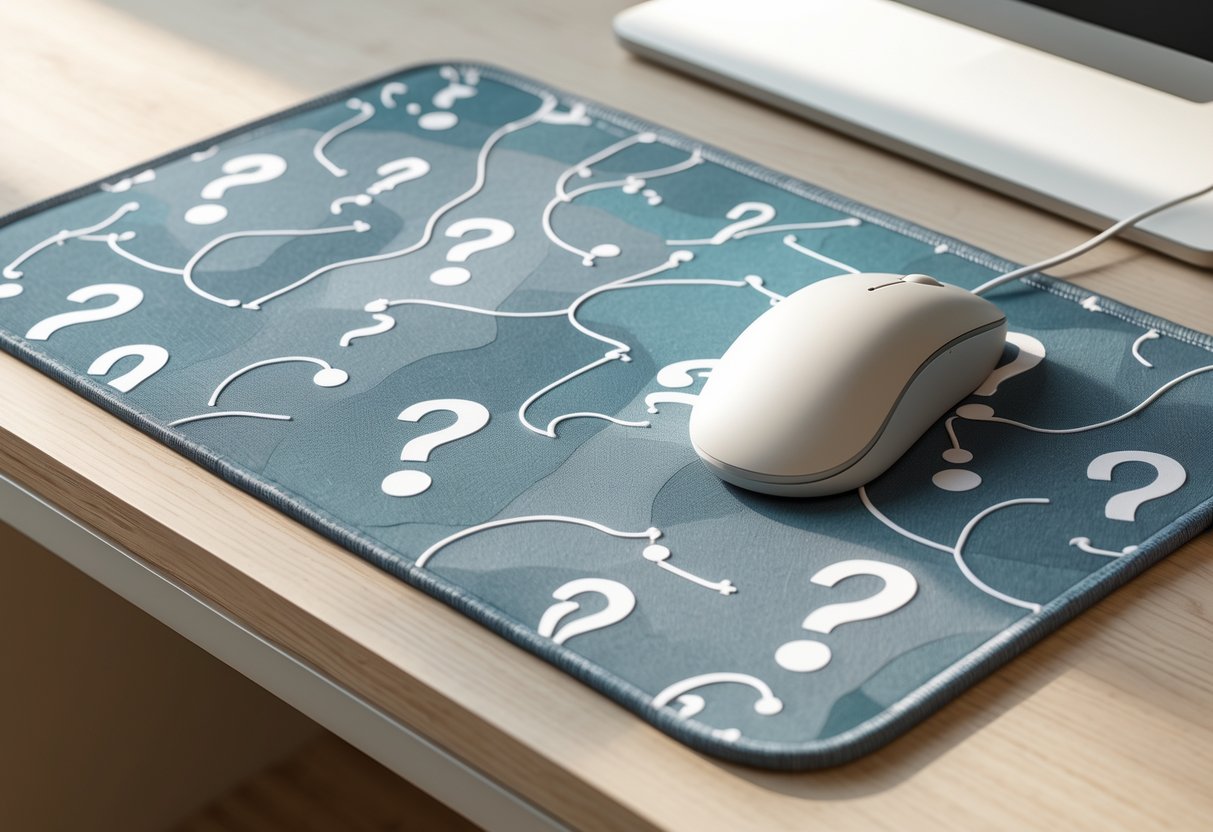
Here are some quick answers about materials, surface differences, sizing, and special options for gaming setups.
What materials make the best mouse pads for gamers?
If you’re all about speed, hard surfaces like aluminium and plastic are the way to go. They let your mouse glide super fast—great for FPS games.
Cloth pads are better for precision and control. The texture helps you stop on a dime and aim more carefully.
Glass pads last a long time but can feel a bit weird. They track really well, but not everyone likes the feel.
Honestly, try a cloth pad first if you’re new to gaming. You can always switch to hard pads if you want more speed later.
How do the surfaces of hard mouse pads differ from soft ones?
Hard mouse pads feel super smooth and reduce friction. You can move your mouse quickly and easily across the whole surface.
The feel stays totally consistent, so your mouse sensor picks up every movement accurately.
Soft pads absorb some of the vibrations and give you more control. The texture grips your mouse a bit, which helps with precise moves.
Cloth pads also feel nicer if you’re gaming for hours. They’re quieter and easier on your hands compared to hard pads.
Can you guide me on the standard sizes for mouse pads in centimetres and inches?
Small pads are about 25cm x 20cm (10″ x 8″). They’re good for high-DPI settings and tiny desks.
Medium pads usually measure 35cm x 25cm (14″ x 10″). Most casual gamers and office workers use these.
Large pads go up to 45cm x 35cm (18″ x 14″) or even bigger. Competitive gamers and folks who use low-DPI settings like these.
Extended pads reach up to 90cm x 40cm (35″ x 16″). They cover your whole keyboard and mouse area.
Are there particular mouse pad materials that are suited for high-performance gaming?
Aluminium mouse pads are the fastest out there. Pro FPS players often pick these for quick flicks and fast spins.
Top-quality cloth pads with tight weaving give you a good middle ground—speed when you want it, control when you need it.
Hybrid pads mix hard and soft materials. You get speed in the middle and comfy cloth at the edges.
Stay away from cheap plastic pads. They wear out fast and mess with your mouse tracking as they degrade.
What are the benefits of using an artisan mouse pad compared to regular types?
Artisan pads use higher-end materials and tighter manufacturing. The surface feels more consistent than mass-produced pads.
Stitched edges on artisan pads last longer and don’t fray as quickly. Regular pads can get rough edges that bug your wrist.
Some artisan pads have custom surface treatments for a unique glide. You can really dial in the balance of speed and control.
A lot of artisan pads are more even in thickness, so you don’t get weird tracking issues from bumps underneath.
Where can one find mouse pad material by the roll for custom projects?
You’ll find that fabric suppliers usually carry mouse pad cloth by the metre. I’d recommend searching for tightly woven polyester or nylon—they’re made for smooth gliding.
Rubber sheet suppliers have the base material you’ll need underneath. Closed-cell foam rubber is a solid pick if you’re after consistent thickness and decent durability.
Some online specialty retailers actually put together complete DIY kits. These kits come with both the surface cloth and a backing, and sometimes the adhesive’s already applied. Pretty handy.
If you want the best quality, check out industrial suppliers. Sure, they cost more, but you’ll get that professional-grade consistency and durability.

